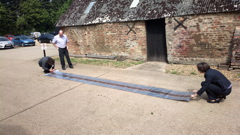CPI Collaborates in Large-Area Flexible Photovoltaics
- Published: October 27, 2014
CLEVELAND, UK | The Centre for Process Innovation (CPI) reports flexible organic photovoltaic (OPV) cells over 6 m long and 50 cm wide have been produced by a recent pan-European collaborative R&D project designated FabriGen. 
The project, which involved six partners from four different countries, manufactured the demonstrator that combines flexible OPV materials with tensile fabrics utilizing roll-to-roll production techniques. The company says16 m2 of active-area material was made for the final demonstrators.
The aim of project FabriGen was to work toward Europe’s ambitious targets for renewable energy generation by bringing new and innovative solar energy products to market. Reportedly, the development of organic photovoltaics with flexible form factors opens up a host of opportunities for designers to embed energy harvesting and functionality into their products, creating the opportunity for new, innovative solar panels that are thinner, have a lightweight large area, and have the potential for lower cost.
Company says the flexible nature of OPV provides a number of advantages to the solar power industry. The ability to produce the panels on fabric or plastic surfaces means that complex shapes and structures can be designed to maximize solar collection. In addition, the technology will enable the production of large area panels to be manufactured in a cost- and resource-efficient manner, promising to bring the cost of solar power on par with that of conventional energy.
FabriGen focused on developing the technology for applications such as large-scale tensile membrane structures. A key aspect of the research was the development and integration of barrier encapsulation layers to provide the long-life performance that is needed for outdoor use.
Dr. David Bird, senior scientist at CPI, says, “The FabriGen consortium has been able to successfully produce a large area working prototype, a significant achievement in the development of low cost, flexible organic photovoltaics. The use of an ITO free front contact facilitated the fabrication of the flexible device. The next steps are focused on upscaling the OPV Fabric to a price point that enables volume production so that we can start to see the emergence of novel applications in the built environment.“
Robert Carpenter, CEO of Inside2Outside (I2O) who coordinated the project, adds, “Delivering the demonstrator from concept to prototype was a real joint effort from all of the consortium. From vacuum processing the metal electrode at CPI, followed by coating the organic semiconductor at Fraunhofer ISE, to printing the silver contacts and the lamination at Coatema and lastly, the high frequency welding of the solar foil on the fabric membrane at I2O, a range expertise was involved.…“




